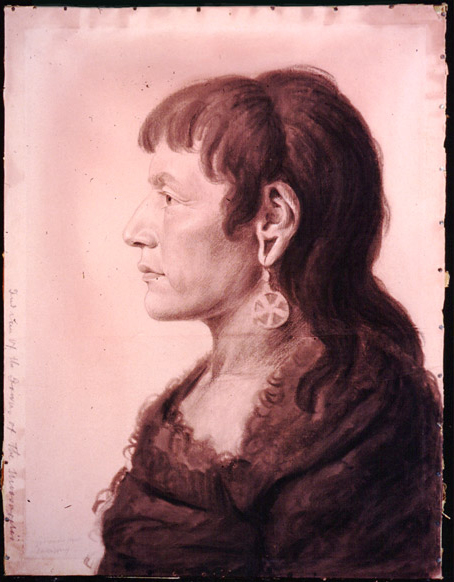Fort Mandan, ND Sheheke (Big White), chief of the Mitutanka village, and his wife, likely Yellow Corn, visit Fort Mandan. She carries 100 pounds of meat and Sheheke tells the Mandan creation story.
Sheheke—”Big White” (1807)
by Charles B. J. F. de Saint Mémin (1770–1852)
Chalk and charcoal on pink paper on canvas, 22-3/8 by 17 inches. #1860.95. Elizabeth DeMilt Fund, Collection of the New-York Historical Society Museum.[1]Lewis commissioned a portrait of Sheheke and one of his wife Yellow Corn for his projected edition of the journals, but he did not write the book after all, and the portraits were not included in the … Continue reading
A Mandan Legend[2]Originally aired weekdays by Yellowstone Public Radio during the Bicentennial observance of 2003-2006. Narrated by Hal Hansen. Scripts by Whit Hansen and Ed Jacobson. Produced by Leni Holliman. © … Continue reading
Cold Day
Clear & cold this morning. a verry hard frost. froze Some last night. we continued our buildings as usal. we unloaded the pearogue [pirogue] in order to fetch Stone.
—John Ordway
Big White Visits
early this morning the Big White princapal Chief of the lower Village of the Mandans Came Down, he packd about 100 W. of fine meet on his Squar for us, we made Some Small presents to the Squar, & Child & gave a Small ax which She was much pleased—
—William Clark
Mandan History
the Mandan nation as they old men Say Came out of where they had Gardins, maney years ago they lived in Several Villages on the Missourie low down, the Smallpox destroyed the greater part of the nation and reduced them to one large Village and Some Small ones, all nations before this maladey was affrd. of them after they were reduced the Sioux and other Indians waged war, and killed a great maney, and they moved up the Missourie
—William Clark
A Common People
The Big bellies Winitarees [Hidatsas] & ravin [Crow] Indians Speake nearly the Same language and the presumption is they were origionally the Same nation The Ravin Indians have 400 Lodges & about 1200 men, & follow the Buffalow, or hunt for their Subsistance in the plains & on the Court noi [Black Hills] & Rock Mountains, & are at war with the Sioux Snake Indians
—William Clark
Weather Diary
Ther. at rise
Weather Wind at rise
Thert. at 4 P.M. Weather Wind at 4 P.M. 18 fair N. 31 fair N E —Meriwether Lewis[3]To assist the reader, the editor of this web page has omitted the “day of the month” and “River Feet” columns and spelled out some abbreviations.
Fort Mandan is a High Potential Historic Site along the Lewis and Clark National Historic Trail managed by the U.S. National Park Service. The North Dakota Department of Parks and Recreation manages a modern reconstruction and the Lewis and Clark Interpretive Center located at US Hwy 83 and ND Hwy 200A.
Knife River Indian Villages National Historic Site is a High Potential Historic Site along the Lewis and Clark National Historic Trail managed by the U.S. National Park Service. A unit of the National Park System, the site is located at 564 County Road 37, one-half mile north of Stanton, North Dakota. It has exhibits, trails, and a visitor center.
Notes
| ↑1 | Lewis commissioned a portrait of Sheheke and one of his wife Yellow Corn for his projected edition of the journals, but he did not write the book after all, and the portraits were not included in the 1814 condensation of the captains’ journals, edited by Nicholas Biddle. Roy E. Appleman, Lewis & Clark: Historic Places Associated with Their Transcontinental Exploration (1804–06) (Washington, D.C.: United States Department of the Interior, National Park Service, 1975), 377n. The artist himself erroneously labeled Sheheke’s portrait, at the left edge, Indien des Iowas du Missoury—“Indian of the Iowas of the Missouri.” Ellen G. Miles, Saint-Memin and the Neoclassical Profile Portrait in America (Washington, D.C.: Smithsonian Institution Press, 1994), 435–36. |
|---|---|
| ↑2 | Originally aired weekdays by Yellowstone Public Radio during the Bicentennial observance of 2003-2006. Narrated by Hal Hansen. Scripts by Whit Hansen and Ed Jacobson. Produced by Leni Holliman. © 2003 by Yellowstone Public Radio. |
| ↑3 | To assist the reader, the editor of this web page has omitted the “day of the month” and “River Feet” columns and spelled out some abbreviations. |



